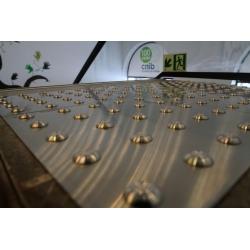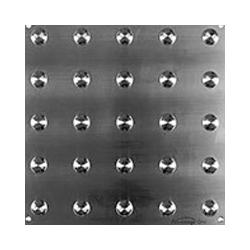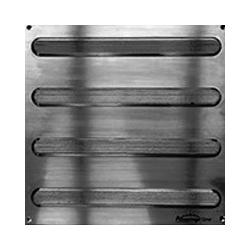Accessibility is a fundamental aspect of creating inclusive environments for individuals, especially those with disabilities. Tactile indicators play a crucial role in facilitating navigation and providing direction, and warnings to people with visual impairments. In recent years, stainless steel tiles have emerged as a popular choice for Tactile Walking Surface Indicators (TWSIs) in different industries due to their properties like durability, versatility, and aesthetic appeal. This article explores the application of stainless-steel tiles as tactile indicators—highlighting their potential to enhance accessibility.
In recent years, stainless steel tiles have emerged as a popular choice for Tactile Walking Surface Indicators (TWSIs) in different industries due to their properties like durability, versatility, and aesthetic appeal. This article explores the application of stainless-steel tiles as tactile indicators—highlighting their potential to enhance accessibility.
What are Stainless Steel Tiles?
These tactile tiles are basically one-plate tiles made from stainless steel. These tiles are designed to be used as tactile indicators for enhancing accessibility in interior spaces. They are fastened to a stainless-steel plate that is applied to the floor. One of the leading manufacturers of stainless-steel tactile indicators is Advantage—which considers durability, slip resistance, aesthetic appeal, and customization to offer the best wayfinding solutions for making inclusive environments.
Their Advantage ONE Plate™ Tactile Walking Surface Indicators features a textured surface on the stainless steel, providing permanent slip resistance. These wayfinding bars or stainless-steel tiles serve both functional and aesthetic purposes by ensuring safety and enhancing the tile’s overall look.
Two Types of Advantage ONE Plate™ Stainless Steel Indicators
- One-Plate with Domes
- One-Plate with Bars
One-Plate with Domes
It’s type of stainless-steel indicator utilizes solid pieces of 316L Marine Grade stainless steel machined into attention domes. These domes are securely fastened to a stainless-steel plate, then applied to the floor surface.

- The purpose of the attention domes is to provide tactile feedback and alert individuals with visual impairments to potential hazards or changes in the environment.
- The domes offer a textured surface for enhanced slip resistance, ensuring safety while enhancing the tile’s overall aesthetics.
One-Plate with Bars
It is another variant of the one-plate stainless steel indicator, consisting of solid steel bars incorporated into a stainless-steel plate. The bars serve as tactile indicators for wayfinding, helping individuals with visual impairments navigate spaces effectively.

- Like the one-plate with domes, the bars feature a textured surface for slip resistance, ensuring safety while providing clear guidance for individuals with disabilities.
- Including these stainless-steel flat bars adds to the overall visual appeal of the tile, contributing to an aesthetically pleasing environment.
The application of stainless-steel bars in interiors
- Parking Areas – Wayfinding bars can be used to direct people toward parking areas, helping them find their way without confusion.
- Wheelchair Ramps: These bars are also used to guide individuals with wheelchairs towards ramps, ensuring that they can access the building safely and efficiently.
- Revolving Door Approaches: Stainless steel wayfinding bars are used to guide people with vision impairment towards revolving doors, making it easier to enter and exit the building.
- Top of Stair Landings – These bars are often placed at the top of stair landings to guide people toward the correct direction they need to go.
- Escalator Approaches: Similar to revolving doors, these bars act as tactile indicators to steer people towards escalator approaches, ensuring they can enter and exit safely.
- Turnstile and Gate Access – One-plate stainless steel bars help people navigate towards turnstile and gate access points, making entering and exiting the building more accessible.
- Transit Platforms: Wayfinding bars are used to guide people toward transit platforms, making it easier to find the right platform and direction of travel.
- Multi-Modal Transit Stations – In large transit stations, stainless steel bars guide people toward different modes of transportation, such as buses, trains, and subways.
Conclusion
By incorporating stainless steel tiles as tactile indicators, builders and contractors can foster more accessibility-empowering individuals with disabilities to navigate public spaces confidently and independently. To get reliable Advantage tactile indicators, you can contact Tactile Solution. They strive to supply all types of Advantage solutions in Canada!
